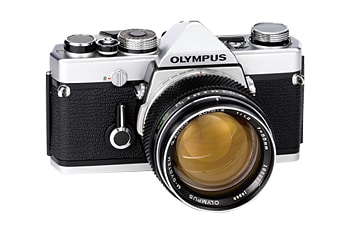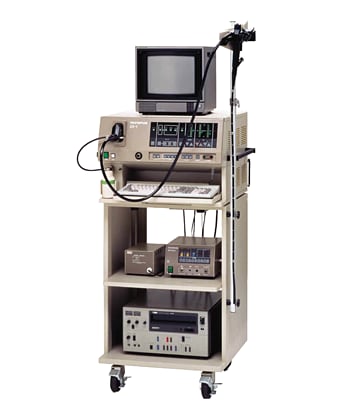- A production site is established in Aizu-Wakamatsu City, Fukushima Prefecture. (Jun. 1970)
- Olympus enters the clinicall analyzer market with the development of the ACA-III automatic biochemical analysis system. (Jul. 1970)
- Ken Kanbe becomes President. (Dec. 1971)
- The Olympus M-1 was launched as a compact, lightweight single-lens reflex camera. It was renamed the OM-1 in the following year (July, 1972.)
- Shigeo Kitamura is appointed President. (Dec. 1973)
- Olympus moves into the rigid medical endoscope field. (Apr. 1975)
- Olympus Camera Corporation is established as a sales base for the United States. (Mar. 1977)
- A production site is established in Nishigo-Mura, Fukushima Prefecture. (Nov. 1978)
- The Olympus XA goes on sale as the world's first barrier-type compact camera. (May 1979)
- An endoscope repair service center is opened in California, U.S.A. (1979)
Olympus Chronology
1970-1989
Expansion of Overseas Sales Networks, Advances in Endoscope Technology
In the period after the two oil crises, Japan experienced an economic boom that eventually became a bubble. Olympus further strengthened its production base and expanded its overseas sales networks to keep pace with export growth.
With microscopes, cameras and medical devices as its three core domains, Olympus also moved into the clinical analyzer market.
With the OM-1 SLR camera, Olympus broke down the prevailing concept of SLR cameras as being bulky and heavy. Olympus also transformed the medical environment with the launch of EVIS-1 endoscope imaging system, which ensured safe, reliable procedures by using videoscope technology to allow all medical professional present to view images on a monitor.
1970s

The Olympus M-1
1980s (first half)

The EVIS-1 endoscopic video system
- The Tatsuno Plant is established in Tatsuno, Nagano Prefecture. (Nov.1981)
- Olympus introduces an ultrasound endoscope system. (Jul. 1982)
- The PK 7000 automatic transfusion blood testing system is introduced. (Apr. 1983)
- The two U.S. sales units are merged into a North American subsidiary, Olympus Corporation (New York State). (May 1983)
- Olympus introduces AH-2 Series, the world's first high-performance microscopes with an AF function. (May 1983)
- The Olympus AFL (Picasso), the world's first compact camera powered by a lithium battery, is launched. (Oct. 1983)
- Toshiro Shimoyama becomes President. (Feb. 1984)
- Olympus adopts a business division structure. (Nov. 1984)
- The EVIS-1 endoscopic video system is introduced. (Mar. 1985)
- Olympus introduces the AU5000 automatic biochemical analysis system. (Jul. 1986)
1980s (second half)
- Olympus launches a magneto-optical (MO) disk drives onto the market. (1986)
- The British company KeyMed Ltd. becomes an Olympus subsidiary. (Feb. 1987)
- Olympus introduces an automatic enzyme immunoassay system. (Feb. 1987)
- A representative office is opened in Beijing. (Jun. 1987)
- The Utsuki Technology Research Institute is opened in Kuboyama, Hachioji City, Tokyo. (Feb. 1988)
Chronology

